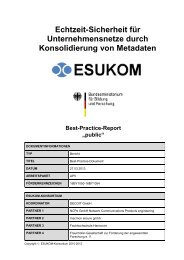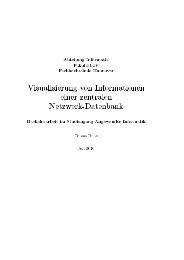Leveraging Trusted Network Connect for Secure ... - esukom
Leveraging Trusted Network Connect for Secure ... - esukom
Leveraging Trusted Network Connect for Secure ... - esukom
You also want an ePaper? Increase the reach of your titles
YUMPU automatically turns print PDFs into web optimized ePapers that Google loves.
The <strong>Trusted</strong> <strong>Network</strong> <strong>Connect</strong> (TNC) approach addresses this issue, specified by<br />
the <strong>Trusted</strong> Computing Group (TCG) with the aim to define a common standard.<br />
Besides the more significant authentication (user and device identification), a<br />
quarantine-zone <strong>for</strong> unsecured equipment has been introduced. TNC avoids any<br />
modifications of devices and thus excludes security lacks caused by weak device<br />
configuration, security breaches in software applications and operating systems. With<br />
this framework the configuration state of devices are communicated to a dedicated<br />
server, which decides upon its trustworthiness.<br />
The core specification has been completed and some products such as switches,<br />
routers, and VPN-gateways are already available in the market. However, a seamless<br />
integration of mobile users into an enterprise user-centric identity management<br />
system is still far from being a reality. Plat<strong>for</strong>m-independent solutions do not exist in<br />
the market. Authentication mechanisms and synchronization of user identities and<br />
rights are not compatible.<br />
Especially <strong>for</strong> SMEs identity management and access is a complex issue and<br />
challenge. This target group cannot af<strong>for</strong>d dedicated departments <strong>for</strong> IT-security and<br />
has to face restricted budgets and personnel resources. As mobile networking and<br />
communications becomes more complex, administration is tedious and error-prone,<br />
demanding mechanisms <strong>for</strong> central administration and configuration. The German<br />
R&D project VOGUE (http://www.vogue-project.de) has identified this problem and<br />
implemented the TNC approach partly in the <strong>for</strong>m of a vendor-neutral prototype. [1]<br />
2 Motivation and Background<br />
Let us consider an enterprise that provides its employee, named Bob, with a mobile<br />
communication device (e.g. smartphone) running several critical business applications<br />
that he require <strong>for</strong> carrying out his job responsibilities. As mobile employee, Bob uses<br />
the firm-owned mobile device to remotely access critical components of his<br />
enterprise’s network and retrieve sensitive business in<strong>for</strong>mation remotely. In order to<br />
limit access <strong>for</strong> non-authorized users and devices, Bob’s enterprise relies on a<br />
traditional network access control approach deployed as a combination of 802.1X,<br />
EAP/EAoP, IPsec and RADIUS. That scenario will lead us to the motivation of the<br />
project VOGUE, the security risks/challenges, and requirements, described in the next<br />
sub-chapters.<br />
2.1 Motivation scenario<br />
In order to enter his employer network, Bob first connect his mobile device to a<br />
wireless access point (AP). The latter can be either a public hotspot or one located at a<br />
<strong>for</strong>eign 1 enterprise network perimeter. By applying the <strong>for</strong>eign enterprise’s and public<br />
hotspot’s operator routing policy respectively, the AP relays Bob and his device<br />
through a potentially unsecured network, i.e. Internet, to his home security gateway.<br />
1 Any network other than Bob’s employer network to which Bob’s mobile device may be<br />
connected.





